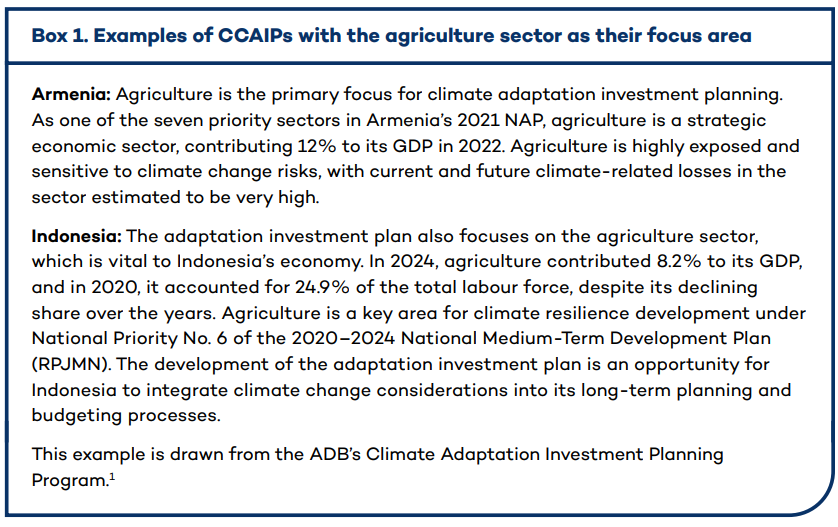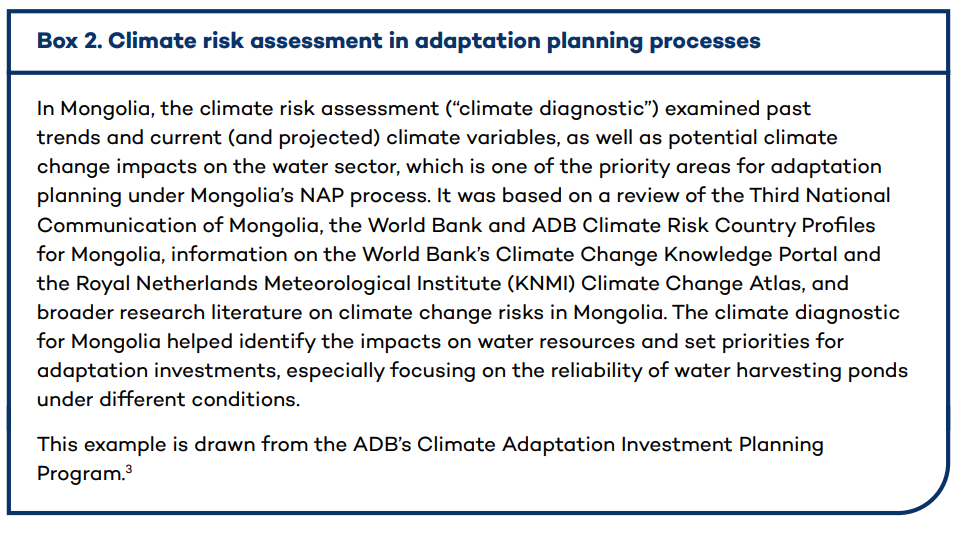What is a climate change adaptation investment plan?
-
Narrowing down and selecting the sector, geographic region, etc. to define the adaptation investment plan’s focus.
This selection is based on various criteria that should be defined by the country. It can include the country’s context, sectors’ or geographic regions’ level of sensitivity to climate change, and sectors’ or regions’ importance in relation to the national development and economic strategies, among others. Countries with a NAP document may start with priority sectors and regions identified in the NAP.
¹ S. M. Gonzales, Asian Development Bank (ADB), personal communication, March 13, 2025.
-
Assessing climate risks and identifying and prioritizing adaptation investments.
Priority adaptation investments are typically “packages” of key adaptation activities designed to enhance the resilience of the selected sector or geographic region of focus. This typically starts with a detailed assessment of key climate risks that might hinder the achievement of the development goals in a sector or geographic region, and the identification of the most suitable adaptation activities.
The identified adaptation activities are then prioritized based on different criteria, such as their contribution to climate resilience, gender equality, social inclusion, biodiversity benefits, alignment with national and sectoral priorities, and the availability of existing technologies and skills.
If a country has a NAP document, it will have outlined key climate risks and identified a set of adaptation priorities. However, even if these steps of climate risk assessment, identification of relevant adaptation options, and prioritization were already completed for the NAP, they may need to be repeated for adaptation investment planning. This is because adaptation investment planning requires a level of granularity and detail that is often not provided in NAPs.
This activity results in a list of priority adaptation investments, which can be bundled into adaptation investment packages to facilitate resource mobilization and the use of specific financial instruments.
Engaging a broad range of actors, such as government agencies, representatives from the private sector, financial institutions, civil society organizations, academia, local communities, and international organizations, is crucial to ensure that the selected adaptation investment packages are relevant, widely supported, and generate equitable outcomes. Given that countries already have engagement processes underway for the NAP process, it’s important to be mindful of the effort required for the development of a climate change adaptation investment plan.
When countries have a highly participatory NAP process, and there’s confidence that the adaptation priorities are representative and will yield equitable outcomes, less broad engagement will be needed for the CCAIP process. However, if the NAP process is less participatory, more engagement will be necessary for developing the CCAIPs. Therefore, it’s crucial to first understand which actors have been involved in the NAP process, how they were engaged, and the extent of their influence on the process. This understanding will help determine the appropriate engagement strategy for the CCAIP process.
² Examples of investment packages could include hard infrastructure projects, such as the construction of water reservoirs, combined with soft measures like establishing early-warning systems, promoting water-saving technologies, educating communities about water conservation and efficient use, training local stakeholders and water managers on best practices for water management and adaptation strategies, and developing and enforcing policies that encourage sustainable water use.
³ S. M. Gonzales, ADB, personal communication, March 13, 2025.
-
Appraising the priority adaptation investment packages to demonstrate their economic and financial viability as well as their adaptation benefits
—ideally using the same criteria that countries apply to assess public investments (see Box 3 for an example). This will help leverage domestic financial resources and facilitate the integration of adaptation investment packages into the public investment management and budgeting systems, thereby increasing their likelihood of being implemented.
Costing adaptation priorities⁴ is also a crucial step in the elaboration of the climate change adaptation investment plan. It enables efficient resource allocation, informed decision making, and strategic financial planning. Accurate cost estimates help appraise adaptation options, ensure transparency, and build trust among key actors.
⁴ The NAP Global Network has developed the NAP Costing Tool, an Excel-based resource designed to help countries estimate the costs of their priority adaptation options. Some countries—such as Fiji, Pakistan, and Albania—are using the NAP costing tool to conduct detailed costing exercises (Ministry of Economy, Government of Fiji, 2020).
-
Matching the adaptation investment package with appropriate sources of finance and financing instruments.
Upon clarifying the specific suite of adaptation measures to be implemented by bundling them together into an investment package, they should be linked to an identified source of finance and the most suitable financial instrument for their implementation.


